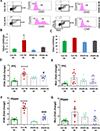Type 1 interferon mediates chronic stress-induced neuroinflammation and behavioral deficits via complement component 3-dependent pathway
- PMID: 33833372
- PMCID: PMC8497654
- DOI: 10.1038/s41380-021-01065-6
Type 1 interferon mediates chronic stress-induced neuroinflammation and behavioral deficits via complement component 3-dependent pathway
Abstract
Chronic stress is a major risk factor in the pathophysiology of many neuropsychiatric disorders. Further, chronic stress conditions can promote neuroinflammation and inflammatory responses in both humans and animal models. Type I interferons (IFN-I) are critical mediators of the inflammatory response in the periphery and responsible for the altered mood and behavior. However, the underlying mechanisms are not well understood. In the present study, we investigated the role of IFN-I signaling in chronic stress-induced changes in neuroinflammation and behavior. Using the chronic restraint stress model, we found that chronic stress induces a significant increase in serum IFNβ levels in mice, and systemic blockade of IFN-I signaling attenuated chronic stress-induced infiltration of macrophages into prefrontal cortex and behavioral abnormalities. Furthermore, complement component 3 (C3) mediates systemic IFNβ-induced changes in neuroinflammation and behavior. Also, we found significant increases in the mRNA expression levels of IFN-I stimulated genes in the prefrontal cortex of depressed suicide subjects and significant correlation with C3 and inflammatory markers. Together, these findings from animal and human postmortem brain studies identify a crucial role of C3 in IFN-I-mediated changes in neuroinflammation and behavior under chronic stress conditions.
© 2021. This is a U.S. government work and not under copyright protection in the U.S.; foreign copyright protection may apply.
Conflict of interest statement
Conflict of Interest:
None.
Figures





Similar articles
-
Complement component 3a receptor deficiency attenuates chronic stress-induced monocyte infiltration and depressive-like behavior.Brain Behav Immun. 2018 May;70:246-256. doi: 10.1016/j.bbi.2018.03.004. Epub 2018 Mar 5. Brain Behav Immun. 2018. PMID: 29518530 Free PMC article.
-
Interferon-β Plays a Detrimental Role in Experimental Traumatic Brain Injury by Enhancing Neuroinflammation That Drives Chronic Neurodegeneration.J Neurosci. 2020 Mar 11;40(11):2357-2370. doi: 10.1523/JNEUROSCI.2516-19.2020. Epub 2020 Feb 6. J Neurosci. 2020. PMID: 32029532 Free PMC article.
-
Microglial type I interferon signaling mediates chronic stress-induced synapse loss and social behavior deficits.Mol Psychiatry. 2025 Feb;30(2):423-434. doi: 10.1038/s41380-024-02675-6. Epub 2024 Aug 2. Mol Psychiatry. 2025. PMID: 39095477
-
Inflammation in the brain and periphery found in animal models of depression and its behavioral relevance.J Pharmacol Sci. 2022 Feb;148(2):262-266. doi: 10.1016/j.jphs.2021.12.005. Epub 2021 Dec 28. J Pharmacol Sci. 2022. PMID: 35063142 Review.
-
Glutamate receptor antibodies in neurological diseases: anti-AMPA-GluR3 antibodies, anti-NMDA-NR1 antibodies, anti-NMDA-NR2A/B antibodies, anti-mGluR1 antibodies or anti-mGluR5 antibodies are present in subpopulations of patients with either: epilepsy, encephalitis, cerebellar ataxia, systemic lupus erythematosus (SLE) and neuropsychiatric SLE, Sjogren's syndrome, schizophrenia, mania or stroke. These autoimmune anti-glutamate receptor antibodies can bind neurons in few brain regions, activate glutamate receptors, decrease glutamate receptor's expression, impair glutamate-induced signaling and function, activate blood brain barrier endothelial cells, kill neurons, damage the brain, induce behavioral/psychiatric/cognitive abnormalities and ataxia in animal models, and can be removed or silenced in some patients by immunotherapy.J Neural Transm (Vienna). 2014 Aug;121(8):1029-75. doi: 10.1007/s00702-014-1193-3. Epub 2014 Aug 1. J Neural Transm (Vienna). 2014. PMID: 25081016 Review.
Cited by
-
Anti-Inflammatory Activity of 1,6,7-Trihydroxy-2-(1,1-dimethyl-2-propenyl)-3-methoxyxanthone Isolated from Cudrania tricuspidata via NF-κB, MAPK, and HO-1 Signaling Pathways in Lipopolysaccharide-Stimulated RAW 264.7 and BV2 Cells.Molecules. 2023 Oct 27;28(21):7299. doi: 10.3390/molecules28217299. Molecules. 2023. PMID: 37959718 Free PMC article.
-
The complement system: a potential target for the comorbidity of chronic pain and depression.Korean J Pain. 2024 Apr 1;37(2):91-106. doi: 10.3344/kjp.23284. Epub 2024 Mar 4. Korean J Pain. 2024. PMID: 38433474 Free PMC article.
-
Molecular mechanisms underlying microglial sensing and phagocytosis in synaptic pruning.Neural Regen Res. 2024 Jun 1;19(6):1284-1290. doi: 10.4103/1673-5374.385854. Epub 2023 Sep 22. Neural Regen Res. 2024. PMID: 37905877 Free PMC article.
-
Mitophagy in depression: Pathophysiology and treatment targets.Mitochondrion. 2021 Nov;61:1-10. doi: 10.1016/j.mito.2021.08.016. Epub 2021 Aug 31. Mitochondrion. 2021. PMID: 34478906 Free PMC article. Review.
-
Dysregulation of complement system in neuropsychiatric disorders: A mini review.Biomark Neuropsychiatry. 2022 Dec;7:100056. doi: 10.1016/j.bionps.2022.100056. Epub 2022 Sep 30. Biomark Neuropsychiatry. 2022. PMID: 37123465 Free PMC article.
References
-
- Marshall PS, Watson D, Steinberg P, Cornblatt B, Peterson PK, Callies A, et al. An assessment of cognitive function and mood in chronic fatigue syndrome. Biol Psychiatry. 1996;39(3):199–206. - PubMed
-
- Beck AT. Depression: Clinical, experimental, and theoretical aspects.1967.
-
- Feinstein A, Brochet B, Sumowski J. The cognitive effects of anxiety and depression in immune-mediated inflammatory diseases. Neurology. 2019;92:211–2. - PubMed
Publication types
MeSH terms
Substances
Grants and funding
LinkOut - more resources
Full Text Sources
Other Literature Sources
Medical
Miscellaneous

